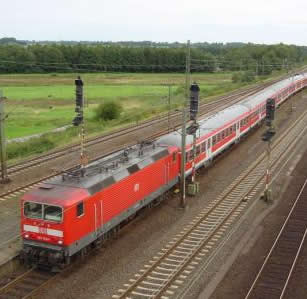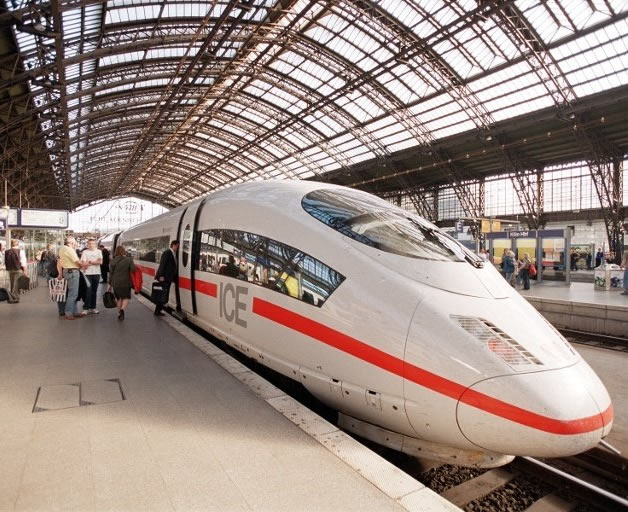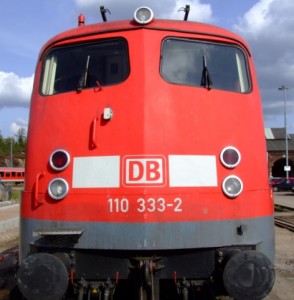Like most western European countries, Germany has a great rail transportation system. Though expensive (unless you are a student), traveling by train is convenient, safe, and comfortable. And best of all, THEY ARE ON TIME. Hear that America? It’s possible to run a train/transportation service that is on time! Now, let’s explore some of the ups and downs of riding trains in Germany and I’ll show you how to save 50% on all train tickets within the country.
The train that you see above is the ICE train in Germany. This is a high-speed train that generally travels long distances. So, if you wanted to go from Cologne to Frankfurt as fast as possible on a train, you would take the ICE. This is a cool train and it provides very comfortable service. Though, it is NOT inexpensive; but, I’ll show you how to reduce your train ticket costs below.
The ICE trains generally have dining cars, smoking sections, second class, and first class. However, I have found that second class is almost as comfortable as first class on ICE trains. Regardless of where you are on the train, you will get a smooth and quiet ride. Also, many trains now offer WiFi internet access and electrical outlets in the seats, regardless of the seat class.
Now, if you want to travel on a more local or ‘regional’ basis, you can take the RE or regional bahn trains.
 These trains can be one level or two levels and are generally for transportation between big cities and the outlying regions. Basically, it’s generally used like a commuter rail. Also, if you are trying to save money, you can often take an RE train the same distance that you might take an ICE train. However, this will take much much longer since the RE is not a fast train.
These trains can be one level or two levels and are generally for transportation between big cities and the outlying regions. Basically, it’s generally used like a commuter rail. Also, if you are trying to save money, you can often take an RE train the same distance that you might take an ICE train. However, this will take much much longer since the RE is not a fast train.
The other alternative to taking the ICE and the RE for long-distance travels, is the IC train. It is basically a hybrid of the RE and ICE trains and travels at an intermediate speed. However, from my experience, you are much better off taking an ICE train if you can afford it and you must travel a long distance. IC trains are generally not comfortable and do not provide for a pleasant riding experience.
German train service is good!
The trains are all air-conditioned (no so in many European countries); the trains are almost always on time to the minute; there are bathrooms on every train car; and the cabins and seats are clean.
German train service is expensive!
As mentioned above, unless you are a student in Germany, you will pay through-the-nose for a train ticket. Now, the prices are tolerable if you rarely travel but, one ICE ride can easily set you back 100 euros or more. The regional trains can set you back 10-15 euros or more for even just a 20 minute ride from one city to the next.
Let’s Save Some Money 25%-50% on Each Ticket
So, like anything in life, you don’t get something for nothing. In order to save money on a ticket, you must first spend money. The German train service offers cards called BahnCards that allow you to reduce the price of a ticket by 25% or 50%. There is actually one card that allows you to ride all trains in Germany without paying for a ticket, but that’s so expensive (4,000 euro) that it’s not worth mentioning here.
At the time of writing this article, the BahnCard 25, which saves you 25% on each ticket, costs 60 euro and the BahnCard 50, which saves you 50% on each ticket, costs 240 euro. Also, each BahnCard is good for one year.
Now that you know how much tickets can cost, especially on ICE trains, you can see just how valuable a BahnCard can be for a frequent traveler to Germany. You can get more information about BahnCards here – https://www.bahn.com/i/view/DEU/en/prices/germany/bahncard.shtml.
In case you were wondering the DB on trains stands for Deutsche Bahn. They control all of the trains in Germany and are like our Amtrak, except better in every way. They provide a great interface for purchasing tickets through their site – https://www.bahn.de.

